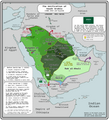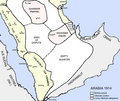The Saudi Arabia Portal – بوابة المملكة العربية السعودية
Flag of Saudi Arabia Emblem of Saudi Arabia
Saudi Arabia's Location
Saudi Arabia Kingdom of Saudi Arabia (KSA ), is a country in West Asia . Located in the centre of the Middle East , it is one of the countries situated in the Gulf region . It covers the bulk of the Arabian Peninsula and has a land area of about 2,150,000 km2 (830,000 sq mi), making it the fifth-largest country in Asia , the largest in the Middle East , and the 12th-largest in the world. It is bordered by the Red Sea to the west; Jordan , Iraq , and Kuwait to the north; the Persian Gulf , Bahrain , Qatar and the United Arab Emirates to the east; Oman to the southeast; and Yemen to the south. The Gulf of Aqaba in the northwest separates Saudi Arabia from Egypt and Israel . Saudi Arabia is the only country with a coastline along both the Red Sea and the Persian Gulf, and most of its terrain consists of arid desert , lowland, steppe, and mountains . The capital and largest city is Riyadh ; other major cities include Jeddah and the two holiest cities in Islam , Mecca and Medina . With a population of almost 32.2 million , Saudi Arabia is the fourth most populous country in the Arab world . (Full article...
(auto-generated)
... that the 2021 film West Side Story transgender character Anybodys?
... that Saudi Arabian broadcaster beoutQ pirated and resold beIN Sports programmes during the Qatar diplomatic crisis ?
... that Saudi Arabian poet Hamad al-Hajji schizophrenia until he died at the age of 49 after a lung disease?
... that the bombing of Mokha Saudi Arabian–led coalition against Yemen , leaving between 65 and 120 dead, including 10 children?
... that Saudi Arabian historian Sa'd ibn Junaydil
... that The Twins Abd al-Quddus al-Ansari
Religions in Saudi Arabia
Arab states
Other countries
This is a Good article , an article that meets a core set of high editorial standards. The McMahon–Hussein letter of 24 October 1915. George Antonius —who had been the first to publish the correspondence in full—described this letter as "by far the most important in the whole correspondence, and may perhaps be regarded as the most important international document in the history of the Arab national movement... is still invoked as the main piece of evidence on which the Arabs accuse Great Britain of having broken faith with them." The McMahon–Hussein correspondence World War I , in which the government of the United Kingdom agreed to recognize Arab independence in a large region after the war in exchange for the Sharif of Mecca launching the Arab Revolt against the Ottoman Empire . The correspondence had a significant influence on Middle Eastern history during and after the war; a dispute over Palestine continued thereafter.
The correspondence is composed of ten letters that were exchanged from July 1915 to March 1916 between Hussein bin Ali, Sharif of Mecca and Lieutenant Colonel Sir Henry McMahon , British High Commissioner to Egypt . Whilst there was some military value in the Arab manpower and local knowledge alongside the British Army, the primary reason for the arrangement was to counteract the Ottoman declaration of jihad ("holy war") against the Allies, and to maintain the support of the 70 million Muslims in British India (particularly those in the Indian Army that had been deployed in all major theatres of the wider war ). The area of Arab independence was defined to be "in the limits and boundaries proposed by the Sherif of Mecca " with the exception of "portions of Syria " lying to the west of "the districts of Damascus , Homs , Hama and Aleppo "; conflicting interpretations of this description were to cause great controversy in subsequent years. One particular dispute, which continues to the present, is the extent of the coastal exclusion. (Full article...
Image 1 Sunset view from
Farasan Island , the largest island of the
Farasan Islands , in the
Red Sea . It is located some 50 km offshore from
Jizan , the far southwestern part of Saudi Arabia.
Image 2 Nasseef House is a historical structure in
Al-Balad ,
Jeddah , Saudi Arabia. As of 2009 it is a museum and cultural center which has special exhibits and lectures given by historians.
Image 3 A view of
Jabal Sawda , a peak located in Saudi Arabia, with an elevation of around 3,000 metres (9,843 ft).
[ 1]
Princess Lolowah in 2008
Category puzzle Select [►] to view subcategories
The following are images from various Saudi Arabia-related articles on Wikipedia.
Image 3 Territorial evolution of the
Third Saudi State (1902–1934) (from
History of Saudi Arabia )
Image 4 Saudi woman wearing a
niqāb in Riyadh. Many women commonly wear a niqab or a burqa in Saudi Arabia. (from
Culture of Saudi Arabia )
Image 5 VOX Cinemas movie theater (center) at
Riyadh Front in 2023 (from
Culture of Saudi Arabia )
Image 6 Bisht Being Sewn in
Al-Ahsa (from
Culture of Saudi Arabia )
Image 7 Sections of Saudi Arabia and neighbouring countries formed a part of the Roman Empire. (from
History of Saudi Arabia )
Image 8 Faisal (left) and Nasser in Cairo, 1969 (from
History of Saudi Arabia )
Image 10 Saudi males dressed and prepared for
ardah , the national dance. It also includes swords, poetry, and singing. (from
Culture of Saudi Arabia )
Image 11 King Abdullah practicing
falconry , a traditional pursuit in Saudi Arabia (from
Culture of Saudi Arabia )
Image 13 The surviving insurgents of the
seizure of the Grand Mosque, 1979 under custody of Saudi authorities,
c. 1980 . (from
History of Saudi Arabia )
Image 14 Abdulaziz (left) and Farouk checking an
Egyptian Army unit in 1946. Other people picture include princes
Fahd ,
Abdullah , and
Mishaal , as well as prince
Muhammad Abdel Moneim . (from
History of Saudi Arabia )
Image 15 Dammam No. 7 , the oil well where commercial volumes of oil were first discovered in Saudi Arabia on March 4, 1938. (from
History of Saudi Arabia )
Image 16 The
tribes of Arabia at the time of the
spread of Islam (expandable map) (from
History of Saudi Arabia )
Image 17 A family fishing in
Jeddah (from
Culture of Saudi Arabia )
Image 19 Abdulaziz Al Saud , founder of Saudi Arabia (from
History of Saudi Arabia )
Image 20 Soldiers in the Arab Army during the Arab Revolt of 1916–1918, carrying the
Flag of the Arab Revolt and pictured in the Arabian Desert. (from
History of Saudi Arabia )
Image 21 The Rashidun Caliphate reached its greatest extent under Caliph
Uthman ,
c. 654 (from
History of Saudi Arabia )
Image 22 Wall painted with Al-Qatt Al-Asiri (from
Culture of Saudi Arabia )
Image 23 Supplicating pilgrim at
Masjid Al Haram , Mecca (from
Culture of Saudi Arabia )
Image 24 Abdulaziz (left) and Roosevelt aboard USS
Quincy during their historic 1945 meeting (from
History of Saudi Arabia )
Image 25 Pakistani workers at Al Masjid Nabawi (the
Prophet's Mosque ) in
Medina (from
Culture of Saudi Arabia )
Image 26 Residential homes in
Yanbu (from
Culture of Saudi Arabia )
Image 27 Red and white
keffiyeh commonly worn in the desert held with a black
agal (from
Culture of Saudi Arabia )
Image 28 The Arabian Peninsula in 1914 (from
History of Saudi Arabia )
Featured articles
Good articles











![Image 3A view of Jabal Sawda, a peak located in Saudi Arabia, with an elevation of around 3,000 metres (9,843 ft).[1]](http://upload.wikimedia.org/wikipedia/commons/thumb/5/59/Al_Sawda_peak.jpg/120px-Al_Sawda_peak.jpg)



















































